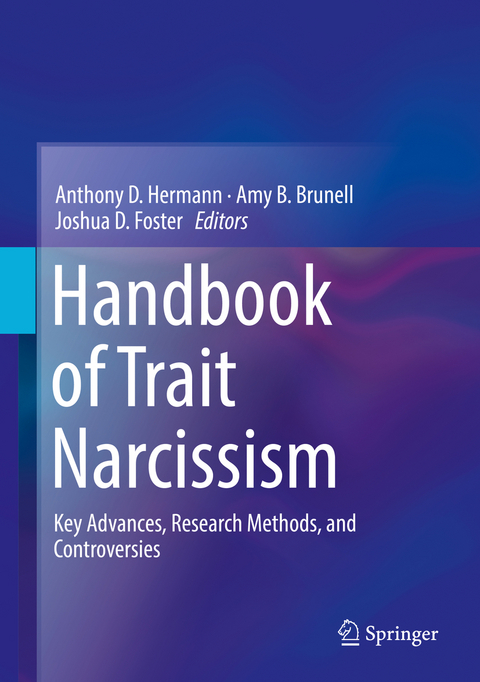
Handbook of Trait Narcissism
Springer International Publishing (Verlag)
978-3-319-92170-9 (ISBN)
Among the topics in the Handbook:
- What separates narcissism from self-esteem? A social-cognitive perspective.
- The many measures of grandiose narcissism.
- Parents' socialization of narcissism in children.
- What do narcissists know about themselves? Exploring the bright spots and blind spots of narcissists' self-knowledge.
- Understanding and mitigating narcissists' low empathy.
- Interpersonal functioning of narcissistic individuals and implications for treatment engagement.
Offering nuanced analysis of a particularly timely subject, The Handbook of Trait Narcissism is fascinating and informative reading for psychologists and psychology students, as well as scholars in anthropology, sociology, economics, political scientists, and more.
Dr. Anthony D. Hermann is a Professor of Psychology at Bradley University in Peoria IL. Professor Hermann received his Ph.D. in Social Psychology at The Ohio State University and has also held faculty positions at Kalamazoo College and Willamette University. He has published papers on the intersection of self-evaluation and social behavior for nearly twenty years. His current research focuses on better understanding the motivations that underlie grandiose narcissists' spiritual, cognitive, and interpersonal behavior. He has received national recognition for his commitment to mentoring undergraduate research and relishes any opportunity has to bask in the reflected glory of his current and former students. Dr. Amy B. Brunell is an Associate Professor at The Ohio State University, Mansfield. She received her M.A. in psychology from the College of William and Mary and her Ph.D. from the University of Georgia in 2007. She teaches courses in social psychology, personality, the self, and interpersonal relationships. Her research concerns the role of narcissism in social contexts, such as emergent leadership, decision making, academic cheating, as well as romantic relationship behaviors. She has published papers in academic journals such as Personality and Social Psychology Bulletin, Journal of Experimental Social Psychology, and the Journal of Research in Personality. She serves on the editorial board of Assessment. She prides herself in conducting and evaluating research with her undergraduate students to help them prepare for graduate school and beyond.
Part I: Definitional and Theoretical Perspectives of Narcissism.- Chapter 1: Distinguishing between Grandiose Narcissism, Vulnerable Narcissism, and Narcissistic Personality Disorder.- Chapter 2: The Narcissism Spectrum Model: A Spectrum Perspective on Narcissistic Personality.- Chapter 3: Perceived Control Theory of Narcissism.- Chapter 4: The Distinctiveness Model of the Narcissistic Subtypes (DMNS): What Binds and Differentiates Grandiose and Vulnerable Narcissism.- Chapter 5: What Separates Narcissism from Self-Esteem? A Social-Cognitive Perspective.- Chapter 6: The Narcissistic Admiration and Rivalry Concept.- Chapter 7: Communal Narcissism: Theoretical and Empirical Support.- Chapter 8: Collective Narcissism: Antecedents and Consequences of Exaggeration of the In-Group Image.- Chapter 9: The Psychodynamic Mask Model of Narcissism: Where Is It Now?.- Chapter 10: Distinguishing between Adaptive and Maladaptive Narcissism.- Chapter 11: State Narcissism.- Part II: Assessment of Narcissism.- Chapter 12: The Many Measures of Grandiose Narcissism.- Chapter 13: Psychometric Properties of the Narcissistic Personality Inventory.- Chapter 14: Using Homogenous Scales to Understand Narcissism: Grandiosity, Entitlement, and Exploitativeness.- Part III: Causes and Development of Narcissism.- Chapter 15: Parents' Socialization of Narcissism in Children.- Chapter 16: The Etiology of Narcissism: A Review of Behavioral Genetic Studies.- Chapter 17: Narcissism and the Economic Environment.- Chapter 18: Narcissism as a Lifespan Construct: Describing Fluctuations using New Approaches.- Chapter 19: Did Narcissism Evolve?.- Chapter 20: Generational Differences in Narcissism and Narcissistic Traits.- Part IV: Intrapersonal Processes.- Chapter 21: Narcissism and Dark Personality Traits.- Chapter 22: Narcissism and the Big Five/HEXACO Models of Personality.- Chapter 23: Physiological Reactivity and Neural Correlates of Trait Narcissism.- Chapter 24: Narcissism and Memory.- Chapter 25: Narcissism and Involvement in Risk-Taking Behaviors.- Chapter 26: How Do Narcissists Really Feel about Themselves? The Complex Connections between Narcissism and Self-Esteem.- Chapter 27: How Does it Feel to be a Narcissist? Narcissism and Emotions.- Chapter 28: Understanding the Narcissistic Need for Perfection: The Most Dazzling, Perfect, and Comprehensive Review Ever.- Chapter 29: What do Narcissists Know about Themselves? Exploring the Bright Spots and Blind Spots of Narcissists' Self-Knowledge.- Chapter 30: Narcissists' Perceptions of Narcissistic Behavior.- Chapter 31: Narcissistic Consumption.- Chapter 32: The Narcissistic Pursuit of Status.- Part V: Interpersonal Processes.- Chapter 33: Early Impressions of Grandiose Narcissists: A Dual-Pathway Perspective.- Chapter 34: Narcissism and Romantic Relationships.- Chapter 35: Narcissistic Qualities and Infidelity.- Chapter 36: Understanding and Mitigating Narcissists' Low Empathy.- Chapter 37: Narcissism and Friendships.- Chapter 38: New Directions in Narcissistic Aggression: The Role of the Self-Concept on Group-Based Aggression.- Chapter 39: Narcissism's Relationship with Envy: It's Complicated.- Chapter 40: Narcissism and Prosocial Behavior.- Chapter 41: Grandiose Narcissism and Religiosity.- Chapter 42: Narcissism and Spirituality: Intersections of Self, Superiority, and the Search for the Sacred.- Chapter 43: Narcissism and Leadership: A Perfect Match?.- Chapter 44: Narcissistic Followership.- Chapter 45: Trait Narcissism and Social Networks.- Part VI: Applied Issues in Narcissism Research.- Chapter 46: Momentarily Quieting the Ego: Short-term Strategies for Reducing Grandiose Narcissism.- Chapter 47: Social Media: Platform or Catalyst for Narcissism?.- Chapter 48: Theoretical Perspectives on Narcissism and Social Media: The Big (and Beautiful) Picture.- Chapter 49: Narcissism and Bullying.- Chapter 50: Interpersonal Functioning of Narcissistic Individuals and Implications for Treatment Engagement.- Chapter 51: The Treatment of Narcissistic Trait and Personality Disturbances.
| Erscheinungsdatum | 08.09.2018 |
|---|---|
| Zusatzinfo | XVIII, 490 p. 12 illus. |
| Verlagsort | Cham |
| Sprache | englisch |
| Maße | 178 x 254 mm |
| Gewicht | 1138 g |
| Themenwelt | Geisteswissenschaften ► Philosophie |
| Geisteswissenschaften ► Psychologie ► Klinische Psychologie | |
| Geisteswissenschaften ► Psychologie ► Psychoanalyse / Tiefenpsychologie | |
| Schlagworte | dark triads in psychology • entitlement • evolutionary roots of narcissism • future research in narcissism • gender and narcissism • grandiose narcissism • health outcomes of narcissism • HEXACO models of personality • narcissism and social media • narcissism and US politics • Narcissistic Personality Inventory • neuropsychology of narcissism • pathological narcissism • positive sides of narcissism • self esteem and leadership • self esteem versus narcissism • the big 5 personality traits • vulnerable narcissism • well-being and narcissism |
| ISBN-10 | 3-319-92170-3 / 3319921703 |
| ISBN-13 | 978-3-319-92170-9 / 9783319921709 |
| Zustand | Neuware |
| Haben Sie eine Frage zum Produkt? |
aus dem Bereich


